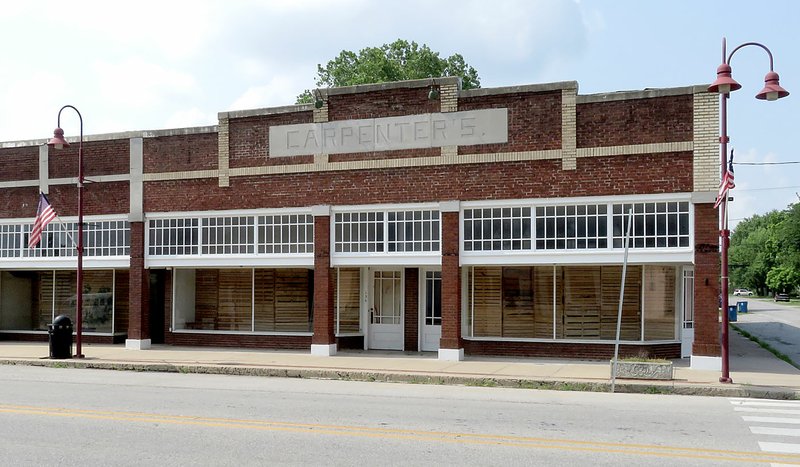GENTRY--The Carpenter Building at 136 East Main Street, built in 1927 from a Craftsman-style design by architect A.O. Clarke, was added to the National Register of Historic Places, the country's official list of historically significant properties.
"From the time of the city's founding in the 1890s until the last quarter of the twentieth century, the Carpenter family operated the city's mortuary and funeral chapel and one of the county's largest grocery and furniture stores," according to the National Register nomination. "The Carpenter Building is one of the largest commercial buildings built in downtown Gentry during a period of major commercial development in the downtown area. Also, this building is one of the most elaborate retail structures in the community and one of the only known architect designed commercial structures along Main Street."
The Carpenter Building is a single-story commercial building constructed of brick and hollow clay tile, according to the nomination form written by Charlie Bookout, one of the building's owners.
The craftsman-style building is home to Mortuary Studios, where Bookout and the other four owners work on creative projects, including art, music and film.
While it may look like urban art space from the inside, "we always called ourselves a rural art studio," Bookout said.
Every October, the building also serves as Carpenter's Mortuary Spook House, which attracts between 2,000 and 3,000 children for Halloween screams.
The building was designed by Albert Oscar "A.O." Clarke, a well-known Arkansas architect who designed the two largest log buildings in the world at Monte Ne, a resort that's now beneath Beaver Lake.
Clarke designed at least 27 structures in Benton, Carroll and Washington counties, including the Benton County Courthouse in Bentonville. The Carpenter Building was constructed from 1927 to 1929. Initially, the building housed a furniture store and grocery store in front along Main Street, and a mortuary in the back.
"The mortuary space included an embalming room, funeral parlor, chapel, and office space in the set of rooms that run along the entire rear of the building," according to the nomination. "The building has survived amazingly intact with only a few alterations since its construction."
Also listed on the National Register were Shumaker Naval Ammunition Depot 500-man Barracks and Shumaker Naval Ammunition Depot Administration Building at East Camden in Calhoun County, C.S. Stuck & Sons Lumber Office Building at Jonesboro in Craighead County, Mount Salem Church and School near Paris in Logan County, Nevada County Courthouse at Prescott in Nevada County, Washington Street Historic District Boundary Increase at Camden in Ouachita County, Lockesburg High School Gymnasium at Lockesburg in Sevier County, Deepwood House near Fayetteville in Washington County and Fulk-Arkansas Democrat Building, Mosaic Templars State Temple and Carmichael House at Little Rock in Pulaski County.
For more information on the National Register of Historic Places program, write the AHPP at 1100 North Street, Little Rock, AR 72201, call the agency at 501-324-9880, send an email to [email protected] or visit www.arkansaspreservation.org.
The AHPP is the Department of Arkansas Heritage division responsible for identifying, evaluating, registering and preserving the state's cultural resources. Other divisions are the Arkansas Arts Council, the Delta Cultural Center in Helena, the Old State House Museum, the Arkansas Natural Heritage Commission, the Mosaic Templars Cultural Center, the Historic Arkansas Museum and the Arkansas State Archives.
General News on 06/06/2018

